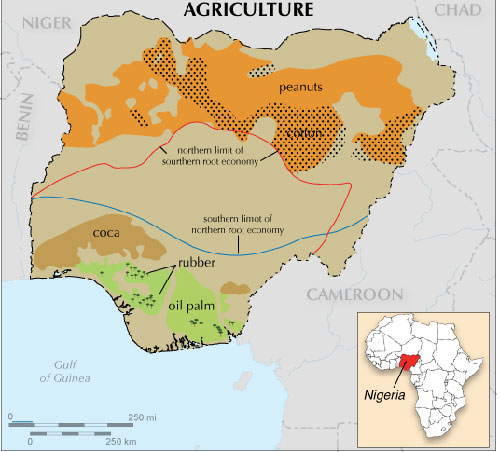Agricultural production in Nigeria
Industry news / Chat on line / Give me a price / Date: February 20, 2016
Nigeria lies between Longitudes 2° 49' E and 14° 37' E and Latitudes 4° 16' N and 13° 52' North of the Equator.
The climate is tropical, characterized by high temperatures and humidity as well as marked wet and dry seasons, though there are variations between South and North. Total rainfall decreases from the coast northwards. The South (below Latitude 8°N) has an annual rainfall ranging between 1,500 and 4,000 mm and the extreme North between 500 and 1000 mm. Nigeria has total area of 923,768 sq km that is divided into land mass of 910,768 sq km and about 13,000 sq km area is covered by water. About 80 percent of Nigeria's land is suitable for farming and grazing, while roughly 13 percent is forested and provides mahogany, iroko, ebony, and other woods. The land use distribution in Nigeria could be classified into 31.29% of arable, 2.96% of permanent crops and 65.75% of others. The irrigated land covers 2,330 sq km. Nigeria is predominantly still an agricultural society (Olaoye and Rotimi, 2001). Approximately 70 percent of the population engages in agricultural production at a subsistence level.
 Agriculture employs almost half of the national workforce but it accounts for only a small fraction of the country's exports and food production has failed to keep up with the country's rapid population growth (Olaoye, 2007). The government has attempted to stimulate agricultural production through a number of measures, including large-scale irrigation schemes and an expansion of credit to farmers. However, the agricultural sector suffered neglect during the hey-days of the oil boom in the 1970s. Ever since then Nigeria has been witnessing extreme poverty and the insufficiency of basic food items. Historically, the roots of the crisis in the Nigerian economy lie in the neglect of agriculture and the increased dependence on a mono-cultural economy based on oil. The agricultural sector now accounts for less than 5% of Nigeria's GDP (Olagbaju and Falola, 1996). As noted earlier, the neglect of the agricultural sector and the dependence of Nigeria on a mono- cultural, crude oil-based economy have not augured well for the well-being of the Nigerian economy.
Agriculture employs almost half of the national workforce but it accounts for only a small fraction of the country's exports and food production has failed to keep up with the country's rapid population growth (Olaoye, 2007). The government has attempted to stimulate agricultural production through a number of measures, including large-scale irrigation schemes and an expansion of credit to farmers. However, the agricultural sector suffered neglect during the hey-days of the oil boom in the 1970s. Ever since then Nigeria has been witnessing extreme poverty and the insufficiency of basic food items. Historically, the roots of the crisis in the Nigerian economy lie in the neglect of agriculture and the increased dependence on a mono-cultural economy based on oil. The agricultural sector now accounts for less than 5% of Nigeria's GDP (Olagbaju and Falola, 1996). As noted earlier, the neglect of the agricultural sector and the dependence of Nigeria on a mono- cultural, crude oil-based economy have not augured well for the well-being of the Nigerian economy.
The climate is tropical, characterized by high temperatures and humidity as well as marked wet and dry seasons, though there are variations between South and North. Total rainfall decreases from the coast northwards. The South (below Latitude 8°N) has an annual rainfall ranging between 1,500 and 4,000 mm and the extreme North between 500 and 1000 mm. Nigeria has total area of 923,768 sq km that is divided into land mass of 910,768 sq km and about 13,000 sq km area is covered by water. About 80 percent of Nigeria's land is suitable for farming and grazing, while roughly 13 percent is forested and provides mahogany, iroko, ebony, and other woods. The land use distribution in Nigeria could be classified into 31.29% of arable, 2.96% of permanent crops and 65.75% of others. The irrigated land covers 2,330 sq km. Nigeria is predominantly still an agricultural society (Olaoye and Rotimi, 2001). Approximately 70 percent of the population engages in agricultural production at a subsistence level.




